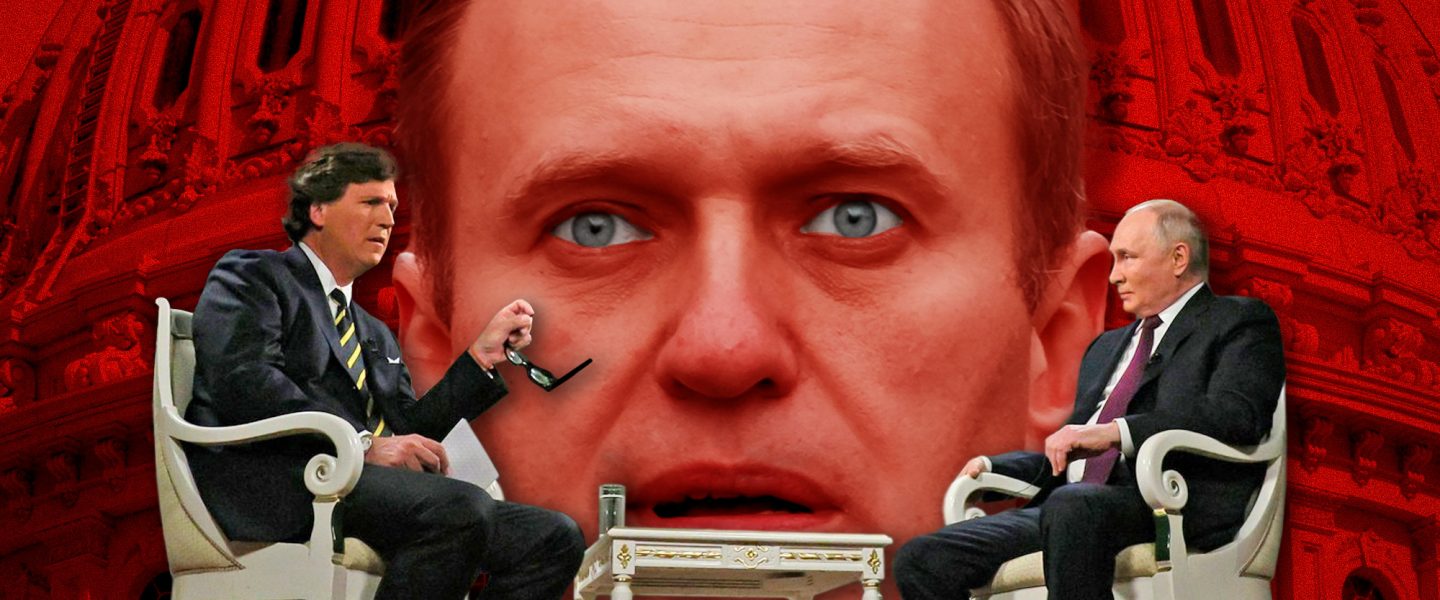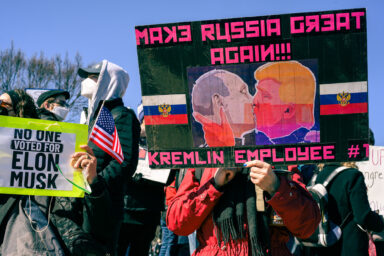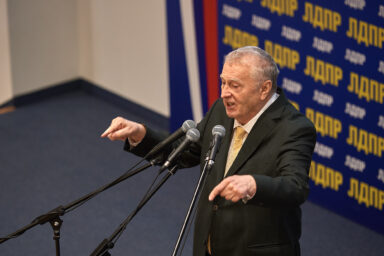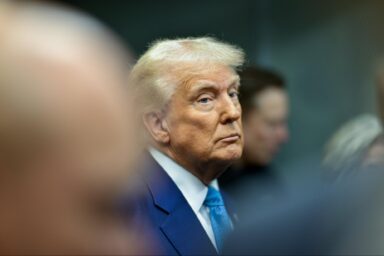Republicans used to be violently anti-communist. Now they’re deciding that they have more in common with the Kremlin than they do with NATO.
|
Listen To This Story
|
America has often had problems with the color red. During the American Revolution, the “red coats” of British soldiers were designed to intimidate and, the British hoped, terrify American colonists demanding independence. It was no accident that officers in George Washington’s Continental Army wore uniforms that were blue. After the Russian Revolution, the color red indicated Bolsheviks imposing Soviet-style communism on Russia and eventually on much of Eastern Europe. Russian tanks in World War II had red stars. The stars on American tanks were white.
Today, red signifies those states that predominantly vote for an increasingly extremist Republican Party. Ironically, those Republicans, who were once obsessed with America’s national security, now find themselves beginning to feel an affinity for objectives very similar to those pursued by Vladimir Putin and the Kremlin in Moscow.
Republicans are in no danger of turning communist. It is the Russians who have cast off any pretense of being communist, or even socialist, while adhering to the totalitarian style that characterized pre-communist, czarist Russia and was briefly repackaged by Joseph Stalin.
Russia has long had a natural instinct for totalitarianism; it’s only the branding that has changed. In his eagerness to recreate what he sees as Russia’s tragic loss of empire after the collapse of the Soviet Union, Putin is selling a simplistic approach to governance. According to his argument, what you really want in order to get things done is a decisive, authoritarian leader who is not overly bothered by the niceties of civilization or, for that matter, the law.
The kind of government Putin has fashioned is closer to a postindustrial version of medieval feudalism than anything else — only Putin relies on oligarchs and corruption rather than on medieval barons. Their job is to impose order on what he clearly sees as a disorderly Russian population that only wants a strong man to tell it what to do. Seen from that perspective, it is not difficult to understand the overriding attraction that Donald Trump feels for Putin. Bromance is, well, bromance. Trump would surely prefer to be in the Kremlin’s camp than have to deal with the fractious arguments in NATO, or for that matter with Western Europe.
Putin’s goal is to make Russia great again. Only in his case, it is by reestablishing the glory of the czars, crushing Ukraine, and sabotaging America’s role as a global leader.
What is more difficult to understand is why a significant portion of the American public seems ready to drink Russia’s Kool-Aid. Trump’s one undeniable skill is as a salesman, who deploys a certain garish charisma and an occasionally amusing, politically incorrect style. But how did literally half the US House of Representatives let itself be convinced to act as “fellow travelers” — not exactly card-carrying agents of a foreign power but reliable allies who willingly provide help from the sidelines?
Tucker Carlson’s lickspittle interview with Putin may shed some light on this. Carlson listened for nearly two hours while Putin lectured him on Russian history, all the while insisting that Ukraine doesn’t deserve to claim a national identity. Forget that countless Ukrainians have laid down their lives in order to fight heroically against an unwanted invasion to which they refuse to surrender. Forget that the original center of the Rus people, who evolved into Russians, was Kyiv, not Moscow, and that the only reason Moscow could dominate the region was that its princes sold themselves to Mongol overlords and agreed to collect taxes for the Golden Horde in exchange for protection.
All that is admittedly in the past, but did Carlson think to ask Putin why Russia felt it was necessary to target Ukrainian shopping malls, public schools, hospitals, and housing complexes with ballistic missiles? Or, to lie to his own population about what he was doing? No, Carlson was too busy basking in the glow of the great man who had inexplicably deigned to give him an interview.
In one sense, Carlson’s behavior is understandable. He knows zilch about Russia, and apparently could not care less about historical facts. You can hate Carlson and what he stands for, but, as Thomas Mann once said of the protagonist in one of his novels, we could hold him responsible for his fate, if he were not so resolutely mediocre as to be incapable of understanding what was happening.
Jon Stewart of The Daily Show once asked Carlson bluntly, “Why do you do what you do?” There was a note of disbelief in Stewart’s voice when he asked the question. Why would anyone do this kind of thing? For money, naturally.
It may all have started with Ronald Reagan, who at first distinguished himself by acting in a number of less than distinguished movies, but nevertheless managed to get elected governor of California and then president. Reagan learned that in an entertainment-obsessed nation, crippled by a short attention span and a news industry that had given way to “infotainment,” substance no longer matters. What counts is presentation and the illusion that there is something there. Reagan discovered that he didn’t have to do much as president — just read from a teleprompter the lines fed to him by a wealth-fueled, corporation-friendly Republican establishment that knew where it wanted to go and hired the best speech writers to get them there.
It turned out that the American public liked the sound of Reagan’s voice. He had a good delivery, and on television that counts a lot. The American heartland found Reagan’s dulcet tones comfortably reassuring. Forget about policy. What have complicated policy debates got to do with daily life anyway? The damage the Reagan years caused became apparent only much later, when the Republican Party began its slide toward irrelevance after Trump took it over.
Trump had mastered his technique after watching the example of a number of TV hotshot predecessors, including ABC’s and then Fox News’s brash reporter Geraldo Rivera, who noted that a certain amount of outrage, and a little violence, tends to wake even the most anesthetized viewers — maybe not forever, but for long enough. After he was physically attacked on camera in 1988, Rivera asked himself which body part he would have to give up next in order to keep up the ratings.
Trump discovered the true power of being outrageous on his own reality TV series, The Apprentice. He quickly sensed the vicarious delight felt by viewers who took guilty pleasure in watching him humiliate contestants on the air. They especially enjoyed the kicker, seeing Trump scowl at a cowering victim and then shout, “You’re fired!”
Around about the time that Trump’s TV series was about to be dumped, in 2015, Trump moved on to politics. The guilty pleasure continued as Trump, the politician, turned his venom against those whom he considered to be the “vermin” of the moment — undocumented immigrants, liberals, Democrats, college-educated professionals, American institutions like the Environmental Protection Agency (who needs clean drinking water, anyway?) and, lately, even the Supreme Court that he himself had packed with anti-abortion conservatives.
Trump’s real enemy, of course, which he calls the “Deep State,” is America’s establishment and the institutions that support it, not to mention basic law and order — something Trump and his family have never taken very seriously. Fundamentally, it is America that Trump hates; but, like all good con artists, he has learned that presenting the opposite of truth as truth can be very effective, at least in the short run.
Where Trump is coming from is pretty obvious; what’s less understandable is the new impact that the Kremlin and Putin have on American “conservative” thinking, which has lately been sliding from the traditional embrace of “family values” and social cohesion to something that looks a great deal like old-style European fascism.
Trump’s early grand strategist, Steve Bannon, made his proclivities clear enough once he was out of the White House, but who would have expected South Carolina’s aging cold-warhorse, Sen. Lindsey Graham, to vote in favor of keeping the US from acting against a threat coming from Russia? When Poland’s Prime Minister Donald Tusk castigated Graham for blocking aid to Ukraine and suggested that Ronald Reagan might want to roll over in his grave, an enraged Graham began shouting at a poster on the wall.
Russia's most incompetent spy, Maria Butina, who pal'd around with conservative American politicians and NRA members, visited Alexei Navalny in prison to try and humiliate him for the RT audience. He dressed her down like the schmuck that she is. Doctors were not even allowed to… https://t.co/HNf0USGqs6
— Veesh21 (@MatrixTMN) February 16, 2024
For their part, the Russians did what they could during the 2016 election to get Trump elected. They bought ads on Google, Facebook, and Twitter (now X) in order to move public opinion in favor of Trump. And then there was the case of Maria Butina, — a Russian spy, or, as the FBI put it, “unregistered foreign agent” — who was taken into custody after the FBI photographed her talking with her alleged Kremlin case officer. Butina’s mission was apparently to penetrate American conservative organizations, including the National Rifle Association, and to clear the way for political contributions to select conservative political candidates. In the end nothing was proved, and the affair remains murky.
The Russians are also believed to have aided Julian Assange and WikiLeaks, who cooperated to upload a trove of documents to the internet weakening Hillary Clinton when she was running against Trump.
In the end, the Russian goal appeared to be to use Trump as a sort of “bull in the china shop;” in other words, to weaken the US by putting an ethics-free disruptor in charge. To a certain extent they succeeded, but something deeper also seems to be happening these days.
It may be that both Putin and extreme conservatism in America are drifting in a direction that is not that different from old-style fascism and that gives both Putin and Trump’s MAGA crowd a common objective — authoritarian rule at home, fueled by rampant xenophobia. After all, Putin’s stated goal is to make Russia great again. Only, in his case, it is by reestablishing the glory of the czars, crushing Ukraine, and sabotaging America’s role as a global leader. Which raises the question: Why are Trump’s MAGA legions so attracted to Russia’s would-be czar?
Speaker of the House, Mike Johnson, received campaign contributions from American Ethane, a company 88% owned by three russians, including russian nationalist Konstantin Nikolaev, who previously funded a russian spy Maria Butina. No wonder he is against the aid to Ukraine. pic.twitter.com/i8mnIWj7v1
— Roman Sheremeta (@rshereme) February 17, 2024
Whether they are consciously siding with the Russians or not, Republicans are doing what they can at least to make sure the US doesn’t get in Putin’s way. Mike Johnson, the Republican speaker who now controls the agenda for the House of Representatives, may insist that he’s worried about America’s southern border, even though at Trump’s command he did what he could to make it impossible for anyone to stop what he himself termed a “crisis.” In fact, confronted with both the US border patrol and Ukraine’s defenders running critically low on supplies owing largely to Republican sandbagging in Congress, Johnson and the entire GOP-led House of Representatives deserted Washington for a two-week vacation.
In any case, desperate refugees from Central America do not have nuclear weapons. The Russians do and, as we’ve just learned, they are contemplating launching them into space. That doesn’t seem to bother Johnson, although recent irrational Republican behavior — not to mention Trump’s invitation for Moscow to attack NATO while the West’s principal defense alliance haggles over money — seems to be bothering just about everyone else.
Regardless of what is driving the Republicans, if they continue to obstruct the US government, Ukraine’s fate will become a fait accompli. In such circumstances, no decision quickly becomes a decision, if only a negative one. A small group of Republicans will have forced America to go back on its word, and an entire Western-aligned population will have been exposed to the threat of decimation. At what point does betrayal become treason? It’s hard to say, but one thing is certain: Vladimir Putin and several other totalitarian dictators are delighted.




